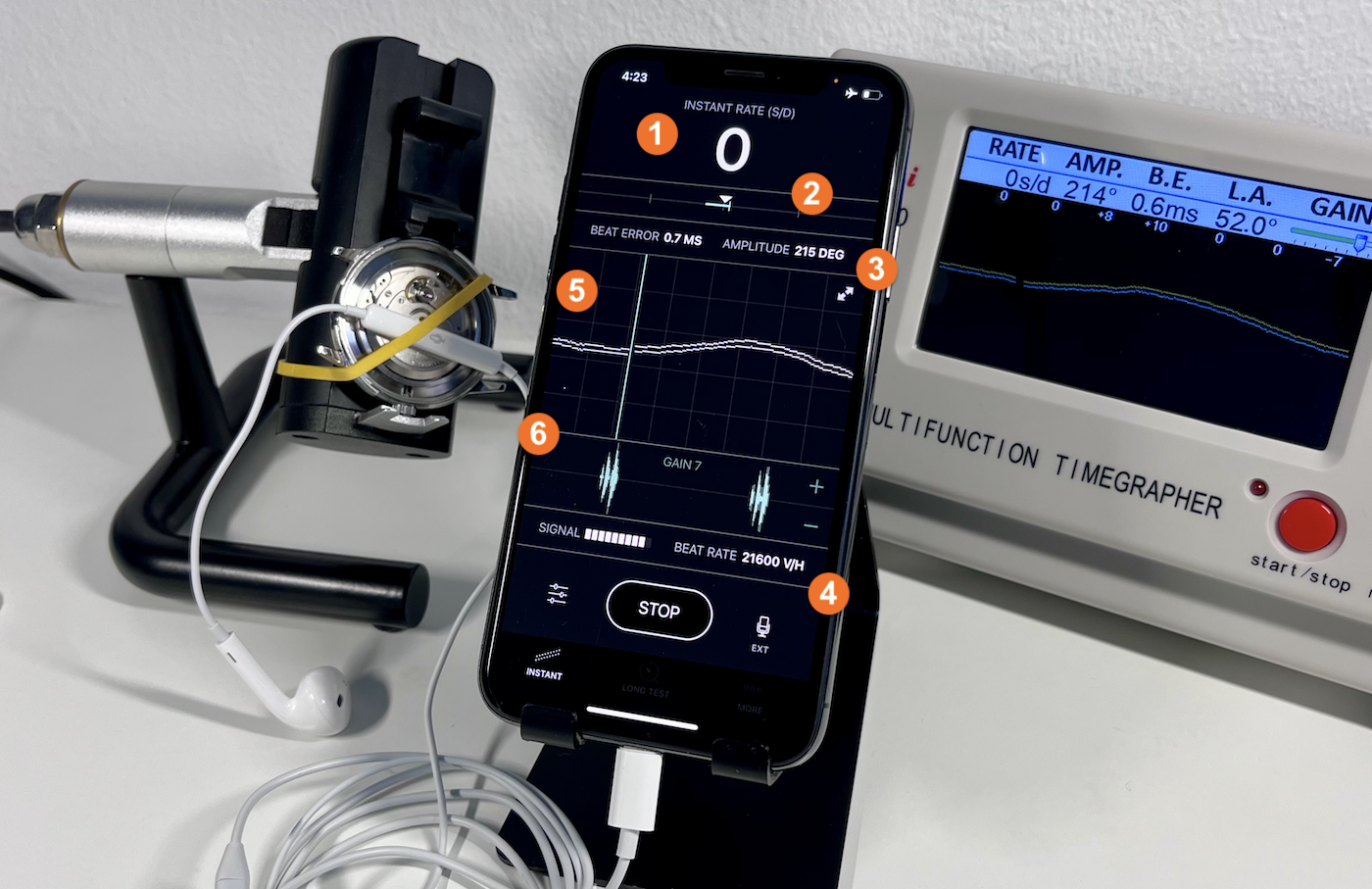
The INSTANT module shows how the watch is behaving in the short term, or "right now". It is very similar to a traditional timegrapher device, with the added benefits of a real-time waveform display and a high-detail diagram display.
1. The Integrated Rate in seconds per day (S/D) is always shown on top. This value is calculated as the mean of all the samples in the preceding integration period. The shorter the integration, the quicker the readout update; the longer the integration, the smoother and more stable the readout.
2. The animated rate gauge is plotted below, to help visually asses fluctuations in rate, even when no clean diagram trace is available. Learn more
3. Estimates of Beat Error in milliseconds (MS) and Amplitude in degrees (DEG) are shown when the signal is strong enough.
4. The signal strength indicator and the watch beat rate in Vibrations per hour (V/H) are shown when signal is detected.
The embedded diagram display [5] behaves similarly to a No.1900-type display. The horizontal time range is fixed to 480
points, with major divisions every 60 points. The error scale is fixed to 25 milliseconds, with major
divisions every 5 milliseconds. Pan up/down to adjust the trace position.
Tap the expand button (upper right) to switch to the high-resolution Fullscreen Diagram Display, which can show up to 1440 points of time range in vertical (Portrait) orientation.
The waveform/scope display [6] shows the audio waveform of the input signal. A real-time plot is constantly
refreshed (dark green), with an average overlaid when a beat is detected (light green). The display fits one
full beat cycle (tick + tock).
Double tap the waveform to launch the experimental Watch Oscilloscope Display, where the ticking sounds can be examined in more detail.
The test settings screen provides the following configuration options:
INTEGRATION — Sets the sample averaging period.
BEAT RATE — The watch beat rate in Vibrations per hour (V/H). Autodetect works for the most
common rates. Set manually for noisy movements or unusual beat rates. Supported rates include 18000, 19800,
21600, 25200, 28800, and 36000 V/H.
LIFT ANGLE — The watch lift angle in Degrees. This value is used for amplitude
calculation.
AMPLITUDE CALCULATION — When the tick and tock sounds differ in length, the amplitude may be calculated
as an average of both. Alternatively the bigger or the smaller value can be used.
The microphone settings screen provides the following information and configuration options:
MICROPHONE — Shows whether the external headset microphone is connected and in use. (*)
HIGH-PASS FILTER — The input signal is filtered so that only the higher frequencies — where the watch
ticking occurs — are processed. This helps to partially eliminate ambient noise. The default HIGH setting is
recommended and works in most cases. Adjust when working with a contact microphone or a beat
amplifier.
SIGNAL GAIN — High gain (7—9) is recommended when working with the headset microphone. Adjust for strong
signals to decrease noise. Gain shortcut buttons (+/-) are available on the waveform display for easier
setup.
* The use of the external headset microphone is always recommended.
For very loud/vintage watches, you may choose to use the iPhone internal microphone. Note that a very close proximity to a device's built-in speakers can magnetize the watch under test. Always ensure a distance at least an inch between the watch and the device.